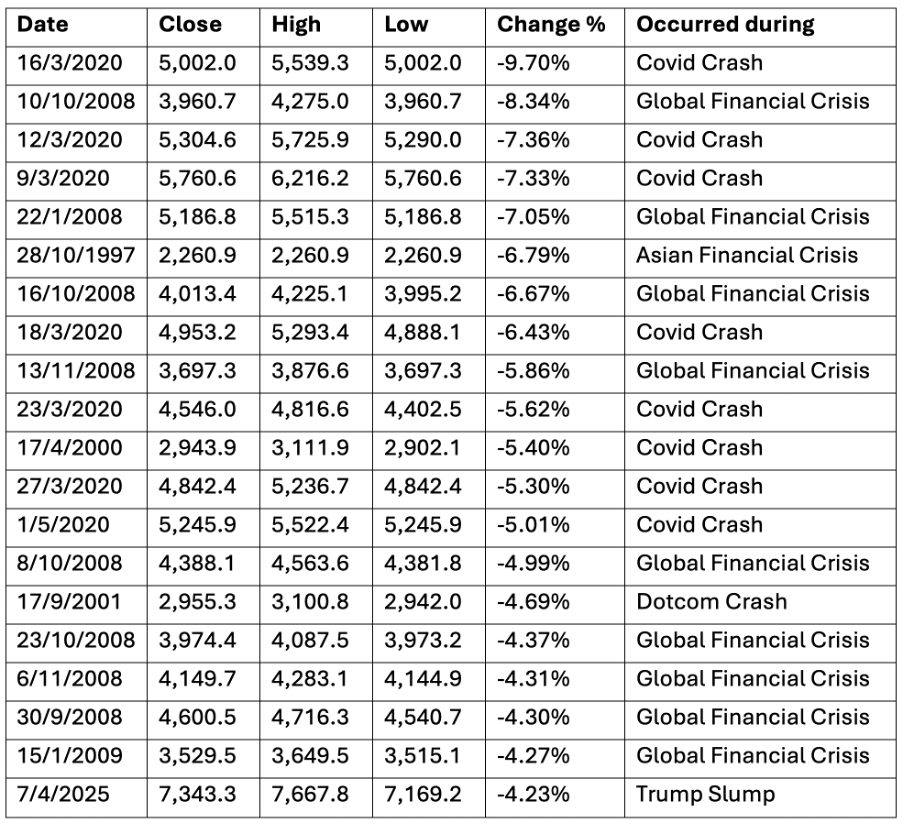The Art of the Squeal: markets react to Trump’s tariffs
Days of pure, unadulterated panic are rare in markets. Since I started watching global markets, the only other days that felt similar occurred either in the GFC or the Covid Crash.
The data backs this up. Looking at the full history of the ASX 200 since 1992, yesterday ranks 20th in the list of worst daily falls. The only times we saw bigger falls were during the Dotcom Crash, the GFC, the Asian Financial Crisis, or the Covid Crash. Ominous, sobering, historic – choose your preferred superlative.
The 20 Worst Falls in the History of the ASX

Source: S&P Dow Jones Indices (data), author (analysis and presentation). As at 8 April 2025.
I can’t tell you whether this will end up looking like the GFC, the Covid Crash, or something else entirely. But one important thing that all these events have in common is that markets recovered afterwards. Sometimes quickly, sometimes slowly, but they recovered.
A quick recap of how we got here
On 4 March, Trump’s long-promised tariffs on imports from Mexico, Canada, and China went into effect. By market-close that day, the ASX 200 and Nasdaq-100 were already down 4.9% and 8.2%, respectively, from their all-time highs in February.
The real item of note wasn’t the price action, it was the fact that the world had changed. Or as A Rich Life put it, The Macroeconomic Zeitgeist Is Changing. We argued on March 5 that it time to sell low-conviction holdings (though not high-conviction long-term investments), ensure your tray table is stowed, and assume the brace position.
A week later, I told Livewire readers to prepare their watchlist for opportunities that might arise during forecast volatility. For those keeping score, the ASX 200 and Nasdaq-100 were down 7.8% and 12.4% from their February highs by close that day.
On 21 March, Trump told reporters that the announcement of reciprocal tariffs (“Liberation Day”) would come on 2 April. Counterintuitively, the markets then calmed, and there were no further significant falls for more than a week.
As we approached the big day, the ocean of global capital remained calm.
Then, at around 7am on 3 April, AEDT, markets opened down, falling as much as 2.1% at one stage, the ASX 200 recovered to be down a modest 0.9%. But when markets opened in the US, they staged their best impression of a lead balloon. The Nasdaq-100 fell 5.4% on 3 April, then another 6.1% on 4 April.
As often happens during times of heightened volatility, the weekend gave investors time to stew, and come Monday, we got a repeat of Friday’s action. Here at home the ASX joined the (panic) party this time, falling 4.2%, though it reached a nadir of -6.5%, during the trading day., what we call a panic day.
One reason markets – and particularly growth stocks – reacted so sharply (as demonstrated by the larger falls on the Nasdaq, or in local tech stocks) is their sensitivity to inflation expectations. Tariffs are fundamentally inflationary - though I’d expect it to be a bigger factor in the US than here.
Things got even more interesting last night. The Nasdaq-100 was initially down 4.9% before a fake Tweet was repeated on air by CNBC led to a 10% trough-to-peak rally. Once the report was corrected, the Nasdaq-100 fell again, but in the end, it closed up 0.2%.
I think there’s an important lesson in last night’s action; markets are not fully pricing in tariffs. They’ve remembered that Trump can turn on a dime, and tariffs can be removed as fast as they were introduced.
Whether they will be or not, I don’t know. The point is they can be, if Trump so deems it.
Post-‘panic day’ – what to do from here
Personally, I doubt we’ve seen the last ‘panic day’ of the Trump Slump.
For one, these days tend to occur in clusters. Of the 56 days that the ASX 200 fell 3% or more, all but seven occurred during the GFC, the Covid Crash, the European Debt Crisis, the Dotcom Crash, or the Asian Financial Crisis.
Secondly, the cause of the crash hasn’t gone away. Trump could change his mind about tariffs tomorrow, or not. But regardless, the US political situation is unstable and unpredictable. If it’s not universal tariffs (including on Heard Island and McDonald Islands, which have a population of zero), I expect Trump will find other ways of causing market instability.
That’s not to say that markets are necessarily destined for further large falls from here. It’s possible we’ve seen the bottom. But nobody knows, and there’s more uncertainty than usual, so as investors, we need to be prepared for any outcome.
With luck, you’ve already reduced risk levels in your portfolio back in March. The important point is that you should not be selling during a panic day.
For those who have dry powder, I believe that panic days are ideal for buying, while keeping in mind that a single volatile period could have multiple panic days in total.
One of A Rich Life’s official recommendations opened down 17.1% on Monday, before closing the day down just 3.8% – up 16% from the low. One of the, shall we say, lower quality names that I made the mistake of not selling in March was down more than 25% yesterday.
Today, it’s up well over 40%.
To prepare for panic days, keep your watchlist up to date, prioritise it, so that you don’t have to think too hard when markets are in free fall.
For example, in a recent episode of The ASX Small Cap Wrap, we looked at Mayfield Group (ASX: MYG), which recently announced a string of contract wins. It’s the kind of stock that can get swept up in a broad selloff – but given its exclusive focus on Australia, it might bounce back quickly when the panic fades. These are the types of opportunities worth keeping an eye on, especially since small-caps can fall a long way on panic days
In the meantime, relax, go outside, and maybe pat some fluffy dogs.
Addendum
I’ve made the assumption that yesterday counts as a ‘panic day’ in this article but haven’t really defined what that is. For me, it’s a day with major falls – say, 3% or more? – where the selling is indiscriminate. Everything is red. How would you define a panic day? Let me know in the comments.
Note: Price data sourced from S&P Dow Jones Indices and Nasdaq, analysis by author.
Disclosure: The author of this article does not own shares in any of the companies discussed and will not trade shares for at least 2 days following the publication of this article. The editor of this article, Claude Walker, owns shares in MYG, and will not trade shares for at least 2 days following the publication of this article. This article is not intended to form the basis of an investment decision and is not a recommendation. Any statements that are advice under the law are general advice only. The author has not considered your investment objectives or personal situation. Any advice is authorised by Claude Walker (AR 1297632), Authorised Representative of Ethical Investment Advisers Pty Ltd (ABN 26108175819) (AFSL 343937).
2 topics
1 stock mentioned

